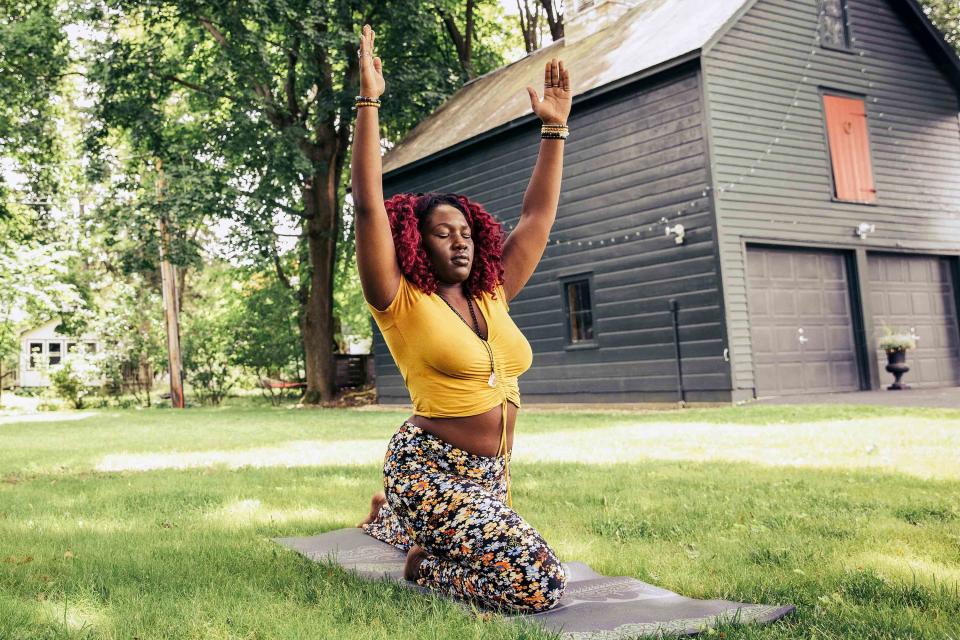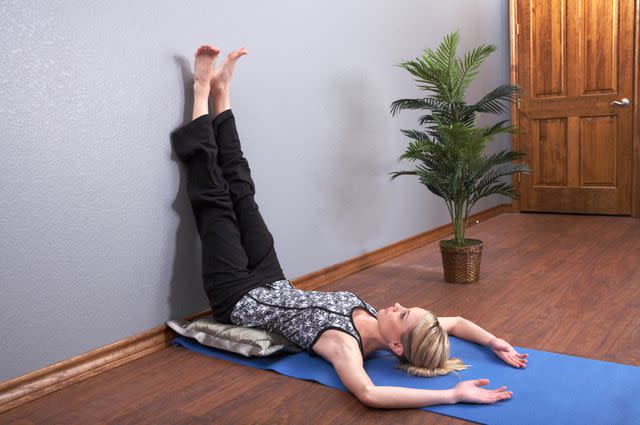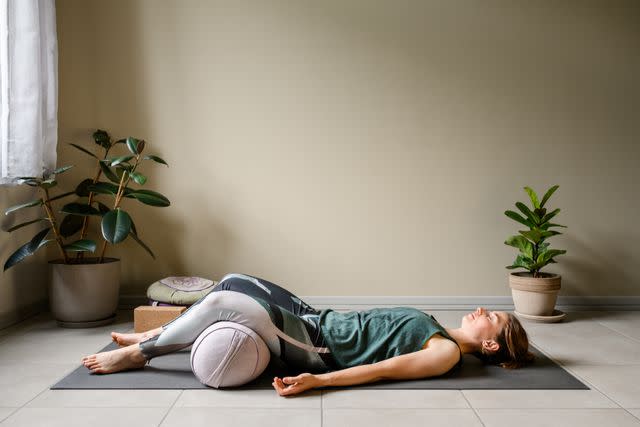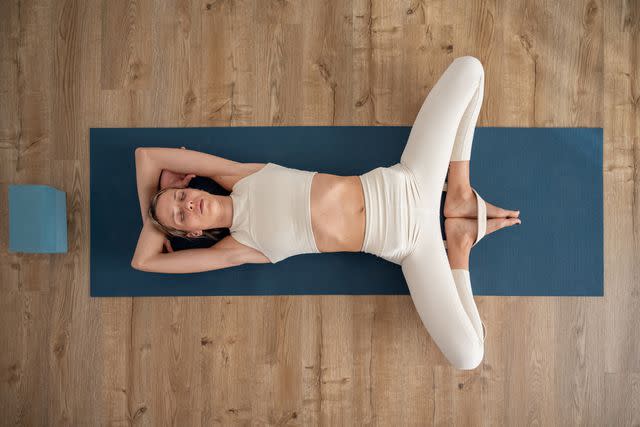Relax and Unwind: The 3 Restorative Yoga Poses You Need to Know for Ultimate Stress Relief

Getty Images
Restorative yoga may not be the first type of yoga fans think of, but incorporating this practice into your workout routine just once per week can have profound effects on your body and mind.
Restorative yoga is a yoga practice with one goal: to unwind. By using various lightweight "props" such as blankets and blocks, you can release stress from the body that has profound effects on the mind as well. Here's everything you need to know about the practice, including how to adopt it into your own fitness routine and how to get started.
What is Restorative Yoga?
"Restorative yoga is a deeply relaxing yoga practice focused on passive stretching and stimulating the parasympathetic nervous system to reduce stress," explains fitness and yoga instructor, Charlie Covey, who currently teaches at Barry's Denver. "This is the part of our brain that helps us 'rest and digest' as opposed to 'fight or flight,' which is triggered by the sympathetic nervous system."
There are a few differences between traditional yoga and restorative yoga. In restorative yoga, for example, poses are held for much longer than you would hold them in a vinyasa class. "Three to five-minute holds are standard, with some poses lasting up to seven minutes," says Covey. "Props are used to help the body find maximum relaxation. You settle into the shape, lay on your props, and let gravity gently do the rest of the work to give you a deep, passive stretch." Sounds heavenly. Are you ready to try it yet?
Benefits of Restorative Yoga
The benefits of restorative yoga are seemingly endless. In addition to helping to relieve chronic pain and aid in muscle recovery, "some studies even suggest that restorative yoga can boost the immune system," says Covey.
Like meditating, restorative yoga can help balance the nervous system, lower blood pressure, and help promote a sense of calm and relaxation. This is thanks to the deep, regulatory breathing experienced in the practice, along with deep stretches.
Essential Props for Restorative Yoga
We've already mentioned props a few times in this piece and it's time to dig into how these relate to restorative yoga practices. "Props, like comforting companions, become our pillars of support, cradling us in comfort and facilitating complete relaxation," explains fitness instructor Samantha Boozer.
Props used in restorative yoga include blankets, bolsters, straps, and eye pillows. "Each prop serves a unique purpose, allowing us to find comfort and ease in every posture," says Boozer. "They assist in reducing strain on the body, encouraging deeper relaxation, and promoting a sense of security and stability."
3 Key Restorative Yoga Poses for Stress Relief and Relaxation
Legs Up the Wall:

Getty Images / tmarvin
This pose can be done almost anywhere; if you're outside you can even lay down and put your legs up against a tree. "It helps stimulate the parasympathetic nervous system, it reverses blood flow from the lower limbs back up towards the core, and it helps realign the spine and alleviate low back tension," says Covey. If you have trouble fully extending your legs, Covey says a great modification is to have them rest on a chair, so the calves would hit the seat of the chair, instead of extending all the way up.
Supported Savasana:

Getty Images / ilbusca
Boozer refers to this pose as a "blissful surrender." It's also known as corpse pose; which means, it's essentially done by laying down. You can put a roller under your knees or a pillow under your neck as needed for support. "For pregnant practitioners, it's best to lay on the side instead, honoring the unique needs of their bodies," says Boozer.
Reclining Bound Angle Pose:

Stocksy
This pose is similar to savasana pose, except for instead of stretching your legs straight out, you fold them into a diamond shape. "Taking the legs into a diamond shape, like butterfly stretch, is a great variation for more opening in the pelvis and inner thighs," says Covey.
Mindful Breathing and Meditation Techniques
Breathwork practiced during restorative yoga is key to gaining its benefits and helping to relax to the nervous system. "Let your breath become your faithful guide, gently leading you into the present moment," says Boozer. "Observe the sensations of your breath, noticing its depth, rhythm, and any areas of restriction in your body. Through this heightened awareness, you can cultivate a profound connection between your body and mind, inviting a sense of inner peace and tranquility."
You don't necessarily have to breathe to a certain pattern, but rather, make sure you are consciously breathing by relaxing the mind, and any tension in the upper body, like in the forehead, the jaw, or the neck.
An easy meditation to try is the body scan technique. Consciously relax and release each part of the body starting from the toes and working your way up to the head.
Creating a Restorative Yoga Routine
As with any yoga practice, it's important to approach your method with kindness, patience, and gentleness, as, according to Boozer, restorative yoga can "unveil repressed feelings and emotions." You can "embrace this gentle observation of yourself, allowing whatever arises to be acknowledged and accepted with kindness," she says.
Restorative yoga classes are offered at most studios, and Boozer says practicing two to three times per week is a great place to start. " As you become more attuned to your needs, listen mindfully to your body and mind, and adjust the frequency and duration of your practice accordingly," she says.
If you want to start out very slowly, try holding a savasana/corpse pose at the end of your regular yoga session. Set a timer if that makes you feel more comfortable, starting at three to five minutes. Focus on your breath, try the body scan method, and try to stay present with yourself and let go of any stressors.
Restorative Yoga As Meditation
Restorative yoga is a great way to meditate without feeling like you're actually meditating. Many of its proponents enjoy the fact that you can practice restorative yoga while laying down and with a comfy blanket and blocks for leg support.
If yoga is something you're interested in, there are many different types and forms to dabble in until you find the one that works best for you. Many yoga professionals incorporate a mix of restorative yoga and physical yoga on a regular basis.
The most important thing is to listen to your body and stay patient. "The effects are cumulative over time as long as the practice is consistent," says Covey. And remember, any form of yoga is better for your body than no yoga at all. If you were recently injured or concerned if restorative yoga is for you, check in with a healthcare provider to see if you might be able to benefit from the practice before starting.
For more Shape news, make sure to sign up for our newsletter!
Read the original article on Shape.

